
The Cyperaceae are a family of graminoid (grass-like), monocotyledonous flowering plants known as sedges. The family is large, with some 5,500 known species described in about 90 genera, the largest being the "true sedges" genus Carex with over 2,000 species.

Carex is a vast genus of more than 2,000 species of grass-like plants in the family Cyperaceae, commonly known as sedges. Other members of the family Cyperaceae are also called sedges, however those of genus Carex may be called true sedges, and it is the most species-rich genus in the family. The study of Carex is known as caricology.
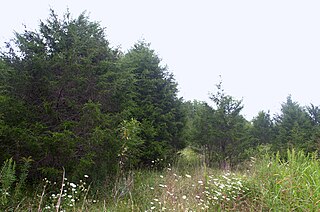
The Cedars Natural Area Preserve is a Natural Area Preserve located in Lee County, Virginia. It protects rare plant and animal species adapted to the unique conditions of a karst landscape.
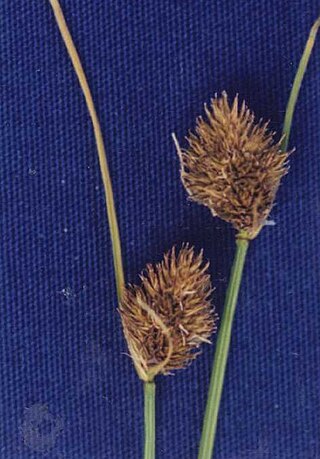
Carex athrostachya is a species of sedge known by the common name slenderbeak sedge. It is native to western North America, including Alaska to central Canada, the western contiguous United States, and just into Baja California.

Carex rossii, commonly known as Ross's sedge, is a hardy species of sedge that is often a pioneer species in areas with little or no established vegetation, or in places where disturbance has occurred. Ross's sedge grows in a variety of habitats throughout much of western North America, from Alaska to Ontario, south to New Mexico and California. It flowers in May and June.

Carex spissa is a species of sedge known by the common name San Diego sedge. It is native to the southwestern United States in California, Arizona, and New Mexico, and far northern Mexico. It grows in wet places such as seeps and streambanks, sometimes on serpentine soils. This sedge looks somewhat like a cattail. It produces angled stems easily exceeding a meter in height surrounded by leathery green to reddish leaves up to about 1.2 meters long. The inflorescence is up to 80 centimeters long, with many long reddish brown flower spikes, each holding up to 300 developing fruits.
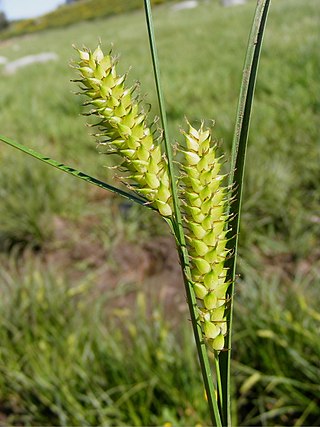
Carex vesicaria is an essentially Holarctic species of sedge known as bladder sedge, inflated sedge, and blister sedge. It has been used to insulate footwear in Norway and among the Sami people, and for basketry in North America.

Carex lutea is a rare species of sedge known by the common names golden sedge and sulphur sedge. It is endemic to North Carolina, where it is known only from Pender and Onslow Counties in the Cape Fear River watershed. There are nine populations. The plant was discovered in 1991 and described to science as a new species in 1994, and it has not been thoroughly studied nor completely surveyed yet. Its rarity was obvious by 2002, however, when it was federally listed as an endangered species.

Carex specuicola is a rare species of sedge known by the common name Navajo sedge. It is native to a small section of the Colorado Plateau in the United States, its distribution straddling the border between Utah and Arizona, and completely within the Navajo Nation. There are several populations but they are limited to a specific type of habitat. The plants grow from the sides of steep, often vertical cliffs of red Navajo Sandstone, in areas where water trickles from the rock. It occurs at elevations between 5,700 and 6,000 feet, usually in shady spots. Though it is not a grass, the sedge grows in inconspicuous clumps resembling tufts of grass sticking out of the rock face. When the sedge was federally listed as a threatened species in 1985, it was known from only three populations in Coconino County, Arizona, with no more than 700 plants existing. The species has since been observed in northeastern Arizona and San Juan County, Utah.

Carex spicata is a species of sedge in the genus Carex.

Carex bigelowii is a species of sedge known by the common names Bigelow's sedge, Gwanmo sedge, and stiff sedge. It has an Arctic–alpine distribution in Eurasia and North America, and grows up to 50 centimetres (20 in) tall in a variety of habitats.
Carex garberi is a species of sedge known by the common names elk sedge and Garber's sedge native to North America.

Carex inops is a species of sedge known as long-stolon sedge and western oak sedge. It is native to northern North America, where it occurs throughout the southern half of Canada and the western and central United States.
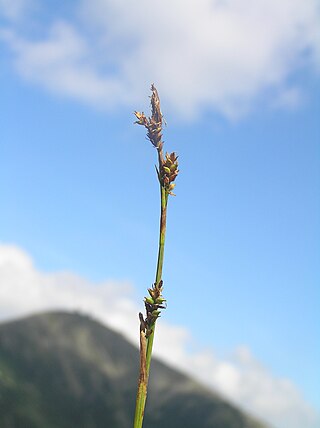
Carex vaginata is a species of sedge known by the common name sheathed sedge.

Carex sylvatica is a species of sedge found in deciduous woodlands across Europe. It typically reaches 60 cm (24 in) tall, and has an inflorescence made up of 3–5 pendent female spikes and a single male spike. It is also used as a garden plant, and has been introduced to North America and New Zealand.
Carex mckittrickensis, the Guadalupe Mountain sedge, is a species of sedge endemic to Guadalupe Mountains National Park in western Texas. It occurs on the sides of steep ravines and also in riparian forests.
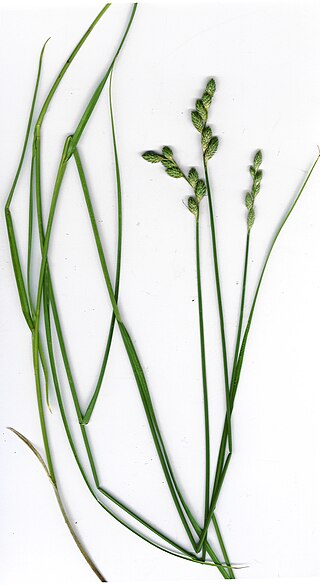
Carex longii, or Long's sedge, is a species of sedge found in North America that was first described by Kenneth Mackenzie in 1922.
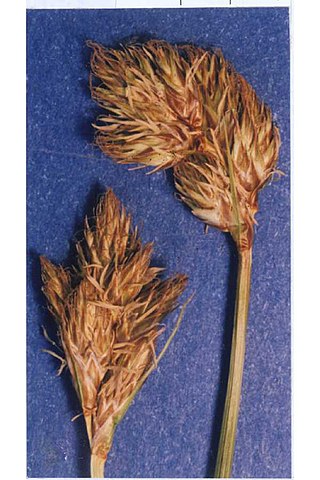
Carex arapahoensis, known as Arapaho sedge, is a species of sedge endemic to the western United States. It is found only in Colorado and Utah in alpine and subalpine habitat.

Carex viridula, known as little green sedge, green sedge, or greenish sedge, is a small flowering plant native to North America, Europe, Asia, and Morocco.

Carex bicolor, the bicoloured sedge, is a species of sedge native to North America, Northern Europe and Northern Asia. The International Union for Conservation of Nature has assessed the plant's conservation status as being of least concern because it has a widespread distribution and faces no particular threats.



















